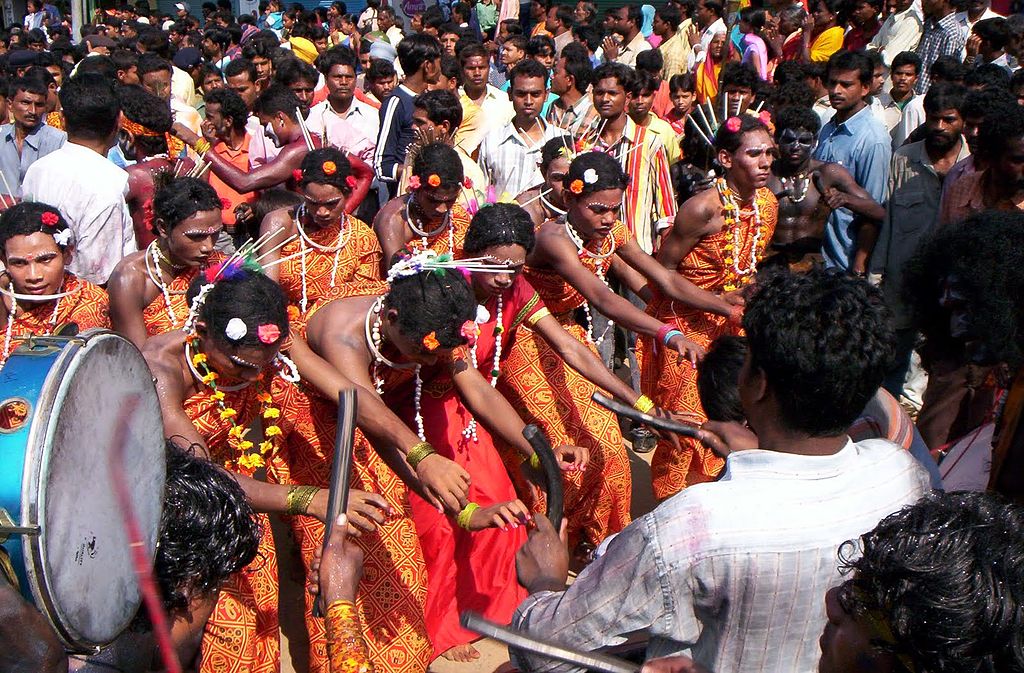Chatar Jatra or Chatar jatra is a traditional festival celebrated by the people of Kalahandi District, Odisha, India. The annual journey symbolises Maa Manikeswari ’s return from Jenakhal to the main temple. It’s held at the exact time when Asthami ends and Navami begins.
Tribal Tradition
Maa Manikeswari, unique to the Kandh tribe-dominated Kalahandi, is considered to be a fusion of Odisha ‘s tribal and non-tribal cultures. And in the celebration of Chhatar Jatra, this is amply reflected.
Earlier, in the ceremonies, both the Royal family and tribals took part and made offerings to the goddess. Now, the festival is being jointly hosted by local citizens and government bodies.

Groups of individuals dressed as traditional Kandha tribal warriors and demons participate in the procession during Chhatar Jatra.
Maa Manikeswari comes to Jenakhal from Garbhagriha on Maha Ashtami in the middle of midnight, which is about 3 km from the alma mater. The jatra begins with Nagar Paribhramana on Maha Navami auspicious morning. Maa Manikeswari is depicted in the jatra by a bamboo covered with black cloth, and Dasamahavidya Yantra is mounted on the silver plate at the top, which reflects Tantric Hinduism. A tribal dance is performed to please Maa Manikeswari, which is known as the Ghumura dance.
You can read our another post on The Leaning Temple of Huma: A Unique Architectural Wonder
Ghumura is a folk dance and a legacy of the district of Kalahandi. It’s a dance performed with the traditional Ghumura Veer Badya instrument. The dancers tie the Ghumura (badya / instrument) on their shoulders and hang it tightly on their chests.
Then there are groups playing Ghanta and others playing traditional instruments like ‘dhola’ and ‘nishan’ to demonstrate the rich heritage of the region, among others.
More local people are interested in dressing up as tribal warriors to showcase the tribal culture and attire. They’re the true celebrities of the day.
New Trends
Earlier, only one musical instrument from the royal family named ‘Dum Baza’ accompanied the procession of the deity. Yet new instruments and stuff have been added in the last couple of years. In Chhatar Jatra this year, 42 Ghanta groups participated.
Chhatar Jatra of Maa Manikeswari, an established folk festival in his native land, has also gained popularity in Chhattisgarh’s neighbouring areas.
A very strange fact about this festival is that there will always be a few pigeons sitting invariably on top of the Chhatar, oblivious of the noises and crowd.
‘Headless’ Deity
But perhaps Maa Manikeswari’s most special practise is the replacement of the head of the deity with a new one on Durga Ashtami. It is a ‘gupta niti’ (secret ritual) referred to as Munda Basa, which comes from two words: munda (head) and basa (to place).
The Devi ‘s head is removed at midnight, as per tradition, and replaced by a terracotta head studded with gems and ornaments. In the Purushottam tank adjacent to the temple, the old head is then immersed.
This terracotta head positioning can seem shocking. But it can be noted that Maa Manikeswari is headless and is thus associated with the Chhinnamasta avatar of Devi Durga. Her body is like a cylindrical frame, with a clay head fixed above it. The body is subsequently coated with clothing and ornaments. On Navami tithi, labelled as Chhatar Jatra, Maa returns to her temple after Nava Kalebara.
More: Wanted to download Odishashop.com visit here
Animal Sacrifice
At this festival, animal sacrifice is prevalent. In the district of Kalahandi, the famous Chatar jatra of Deity Manikeswari of Bhawanipatna ends with the congregation of nearly three lakh devotees and many goats sacrificed on the streets.
While the state has specifically prohibited these types of practises, the law is still not followed by devotees. At this festival, about 50,000 animal sacrifices take place.
In addition to the sacrifice of goats, pigeons are often released by thousands of devotees as a mark of wish fulfilment.
How to Reach Kalahandi
By air: The closest airports are Raipur, Bhubaneswar, Visakhapatnam.
By Train: Kesinga, Bhawanipatna and Junagarh are the closest stations.
By Road: Linked to Bhubaneswar, Visakhapatnam and Raipur. NH-26 passes through the district.

